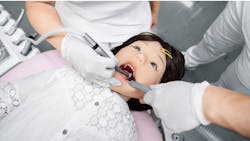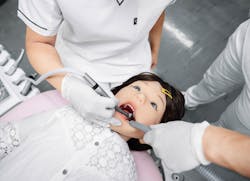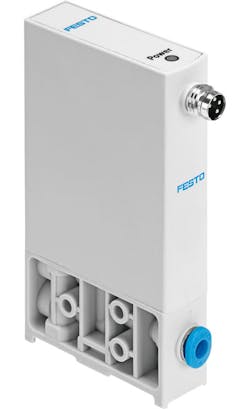Pneumatic Robot Tyke Visits the Dentist
A fear of the dentist is usually caused by negative past experiences. But when it comes to children, that fear can be compounded by the dental professional’s chairside competence.
Hard-won training for pediatric dentists may include courses in the psychology of how the child thinks and feels about dental work, but also on anticipating how the child might move in the dental chair.
The Japanese company Tmsuk has developed a dental patient simulator that mimics a child’s behavior in ways that dental professionals may encounter. The dentaroid is capable of face and voice recognition. It can perform 24 actions, including coughing, fidgeting, squirming, flinging and clenching teeth. It can also reproduce complex actions, such as jaw closing and a vomiting reflex.
Known as Pedia Roid, the pediatric patient robot is 3 ft., 6 in. tall and weighs about 50 lb, approximating the size of a five-year-old. Its lifelike movements are produced using proportional pressure regulators with piezo technology.
Yusuke Ishii, director of Tmsuk, noted in a press note that Festo’s VEAA and VEAB proportional pressure regulators are used in the application to control most of the robot’s 24 pneumatic cylinders moving the robot’s arms, legs and fingers, as well as the mouth, eyelids and irises. “The proportional pressure regulators VEAA/VEAB are 3/3-way valves, each of which combines a pressure sensor and electronic controls,” said Ishii.
“Proportional valves with piezo technology require virtually no energy to maintain an active state thanks to their capacitive capability,” said Ishii. Each valve operates like a capacitor: it needs energy only to charge the piezo ceramics; no further energy is needed to maintain that state.
The piezo valve operates like a capacitor. Current is needed at the start to charge the piezoceramics, explained Festo, and since no further energy is needed to maintain its state, the valves don’t heat up. Piezo valves consume up to 95% less energy than solenoid valves, which require an electric current.
While Pedia Roid is the first robot developed for the field of medical simulation, it is not the first time Tmsuk has brought a service robot to market. The company, which is located on the island of Kyushu, has built a niche in transport robots and robots for caring for the elderly.
About the Author

Rehana Begg
Editor-in-Chief, Machine Design
As Machine Design’s content lead, Rehana Begg is tasked with elevating the voice of the design and multi-disciplinary engineer in the face of digital transformation and engineering innovation. Begg has more than 24 years of editorial experience and has spent the past decade in the trenches of industrial manufacturing, focusing on new technologies, manufacturing innovation and business. Her B2B career has taken her from corporate boardrooms to plant floors and underground mining stopes, covering everything from automation & IIoT, robotics, mechanical design and additive manufacturing to plant operations, maintenance, reliability and continuous improvement. Begg holds an MBA, a Master of Journalism degree, and a BA (Hons.) in Political Science. She is committed to lifelong learning and feeds her passion for innovation in publishing, transparent science and clear communication by attending relevant conferences and seminars/workshops.
Follow Rehana Begg via the following social media handles:
X: @rehanabegg
LinkedIn: @rehanabegg and @MachineDesign


